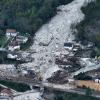
IIASA researchers Robert Sakic Trogrlic and Stefan Hochrainer-Stigler explore the growing complexity of natural hazards and their interconnected impacts on communities. Their research offers insights into the challenges faced by communities worldwide and underscores the importance of building more resilient systems in an interconnected, increasingly hazard-prone world.
As natural hazards continue to grow in frequency, magnitude and complexity, many communities are increasingly exposed to multi-hazard scenario situations. Natural hazards, such as storms, floods, earthquakes, and droughts, are not isolated events. Instead, they often trigger or amplify one another, happen consecutively, or their impacts compound in time and space, leading to more severe impacts on societies, infrastructure, and economies. We are reminded of this multi-hazardous reality on an almost daily basis. For instance, in September 2024, parts of Austria suffered compound riverine, surface, and groundwater flooding, and in early October this year, areas of central Bosnia and Herzegovina were devastated by compounding floods and landslides.
Understanding multi-hazard risks in Europe
In recent years, Europe has seen an increase in multi-hazard events. These include, for example, floods, heatwaves, wildfires, and earthquakes, which often occur simultaneously or consecutively. Our study highlights the current shortcomings in disaster risk reduction frameworks. This research, conducted across five European regions (the Canary Islands, the Danube Region, the North Sea, Scandinavia, and Veneto) identified fragmented governance and siloed approaches that dominate current disaster management strategies as the major challenge, resulting in lack of prevention and preparedness to multi-hazard risks.
For example, government agencies are often structured to deal with single hazards, which hinders effective collaboration and resource allocation for interconnected risks. European stakeholders emphasized the importance of conducting risk assessments across multiple hazards and their interconnected impacts and developing more comprehensive disaster preparedness plans.
Some of the key challenges identified include:
- Fragmented governance: Multiple agencies work in isolation, focused on single hazards and with no clear responsibilities for multi-hazards.
- Funding limitations: Funding for disaster risk management is already limited, with funds further limited for interconnected risks.
- Knowledge gaps: There is a need for better data and research on how different hazards and risks interact and how this could evolve under changing climate and future socioeconomic developments.
- Lack of data: Data on past multi-hazard events and their impacts are missing.
- Existing approaches to disaster risk management: Approaches remain single-hazard and single-sector focused with limited cross-sectoral interactions.
- Science-policy translation: Translating complex scientific data into actionable policies remains a hurdle.
Despite these challenges, our work points to emerging frameworks and tools that should help overcome these obstacles. These include more collaborative approaches with local stakeholders, better integration of multi-hazard thinking into policy, and the development of harmonized frameworks for systemic and multi-hazard risk assessments.
Urban disaster risks in megacities: The case of Nairobi and Istanbul
Another recent study of ours examined multi-hazard risks in rapidly growing urban areas. These cities face complex challenges due to the multiplicity of natural hazards like floods, earthquakes, and landslides and their interactions. We systematically mapped 19 natural hazard types for Nairobi and 23 for Istanbul, along with their interrelationships. For example, in Istanbul, an earthquake can trigger landslides, which in turn could lead to secondary impacts like flooding.
One of the significant insights from this research was the lack of integration of multi-hazard scenarios into current urban disaster risk reduction efforts. In both cities, governance challenges—similar to those seen in Europe — pose a barrier to effective risk management. Local stakeholders reported that siloed approaches often lead to disjointed planning and implementation of disaster risk reduction strategies. However, there are opportunities for improvement, especially with growing awareness among urban policymakers about the need for multi-hazard preparedness.
Looking forward and building resilient systems
Both studies underscore a critical point: disaster risk management must evolve to reflect the interconnected and systemic nature of disaster risks. For Europe, this means rethinking governance frameworks to address multi-hazard risks holistically, including enhanced cooperation across different layers of governance, clear responsibilities for multi-hazard risk management, shared resources, and further research efforts. For rapidly urbanizing areas like Nairobi and Istanbul, it involves embedding multi-hazard thinking into the different stages of urban planning and development.
At IIASA, we developed a framework for systemic and multi-hazard risk management to help decision-makers deal with complex multi-hazard risks across different settings. Importantly, we suggest that single, multi-, and systemic risks are not distinct, but represent a risk-continuum and therefore should and can be simultaneously dealt with.
As our research highlights, multi-hazard risks require comprehensive and integrated strategies that break away from the limitations of siloed, single-hazard frameworks. By fostering collaboration, enhancing governance, and embedding multi-hazard thinking into both policy and urban development, we can better prepare for the interconnected threats that define our modern world. Ultimately, building resilience is not just about managing individual risks, but about creating systems robust enough to withstand the cascading impacts of multiple hazards across regions and sectors.
Note: This article gives the views of the author, and not the position of the IIASA blog, nor of the International Institute for Applied Systems Analysis.
